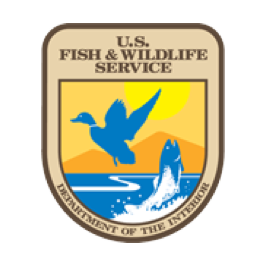Standing Rock Sioux Tribe Game and Fish Program Partners with USFWS to Release Black Footed Ferrets
October 31, 2022
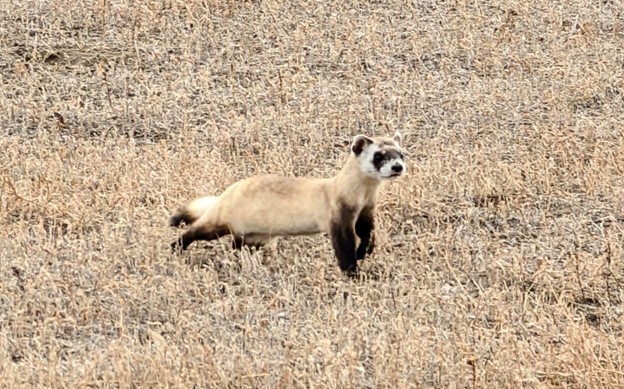
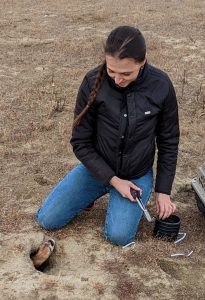
Amity Bass holds still, she has seen Ferrets latch on with their carnivorous razor sharp teeth when intimidated.
On Wednesday October 26, 2022, the Standing Rock Sioux Tribe Game and Fish Program partnered with the U.S. Fish and Wildlife Service to release 13 pairs (male and female) of Black Footed Ferrets on the reservation.
Amity Bass, the U.S. Fish and Wildlife Service’s Field Supervisor with the North and South Dakota Ecological Services from Pierre, South Dakota described how innocent-looking but vicious the Black Footed Ferret can be. “Working towards rehabilitating the species has been a lot of work but it is a rewarding experience. We will come back in one year during the night because they are nocturnal animals, and survey how well they are doing”.
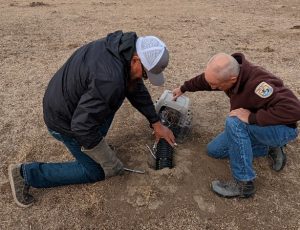
Councilman Demery and biologist John Hughes releasing the first female Black Footed Ferret in October 2022
Kenel District Councilman, Delray Demery, was given the opportunity to release the first Black Footed Ferret, a female, into the wild, stating, “It was very exciting to actually take part in something of this magnitude, helping with both the prairie dog population and providing a natural home for an endangered species. Hopefully this method of (prairie dog) control is a long-term way to balance the natural environment. I think that it was an experience of something important to take part in, since the ferret is considered an endangered species and to handle an endangered species was an honor. I saw photos of them before, and a stuffed one but this was the first time I have seen one alive and up close. When I released it, it actually really startled me. It screeched and barked at me but it was exhilarating to release one to go do what they do. The biologist said it (prairie dog) was their main diet. If the balance of prairie dogs is achieved, and if the ferret population is a success, I can actually say I took part in it, something important to our natural environment.”
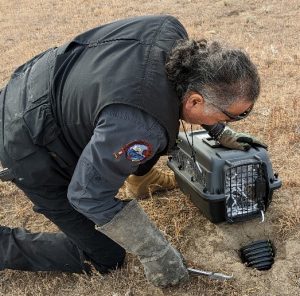
Jeff Kelly, SRST Game and Fish Director releasing the Black Footed Ferret
Standing Rock Game and Fish Director, Jeff Kelly, stated, “This is the second release of Black Footed Ferrets on Standing Rock. The U.S. Fish and Wildlife Service releases 400 every year and of that, Standing Rock received 26. Our hope is that the 13 pairs of breeding mates released will repopulate and thrive in their new environment. Working with the Fish and Wildlife Service on this is an honor, and testament that our last release of ferrets was successful, having another release done this year.”
“The natural predator of the Black Footed Ferrets are birds of prey/raptors (eagles, hawks, owls), coyotes, and badgers”, stated Amity Bass, Fish and Field Supervisor for the North and South Dakota Ecological Services from Pierre, SD. She also stated that though the Ferrets are known to help control the prairie dog population, they do not wipe out the (prairie dog) colonies.
John Hughes and Justin Chauvin, Wildlife Biologists in the U.S. Fish and Wildlife Service’s Black Footed Ferret Recovery Program in Carr, Colorado explained the process of readying the Ferrets for integration into the wild. Justin stated, “We prepare them by preconditioning them using various methods similar to what they might experience in the wild. They are also vaccinated and marked with a tracker, similar to microchips place in dogs and cats. So far, this process has been a success and I’m hopeful that this bunch of Ferrets will do well here”.
Black Footed Ferrets were originally thought to have gone extinct in 1967, due to both a major eradication in their primary diet source, the Prairie Dog, from poisoning and plague. Since that time, a group of the Black Footed Ferrets were captured and used as the foundation of a conservancy project that has since been vital to their continued gradual growth and existence.
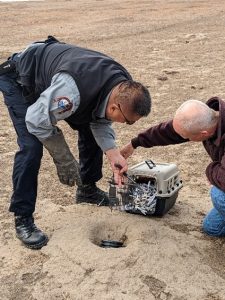
SRST Game and Fish SRO, Gary Weasel preparing for a successful release.
Though the Black Footed Ferrets are still considered an endangered species, the Standing Rock Sioux Tribe will continue to work with the U.S. Fish and Wildlife Service to help the Black Footed Ferret make its way off the endangered species list. When the Chairwoman of the Standing Rock Sioux Tribe was asked what she thought about the release of the Ferret, she responded, “I am so happy and congratulate Jeff Kelly and our Game and Fish Department with their partnership with the U.S. Fish and Wildlife Service to integrate this little relative of ours. I love that this integration and introduction is to complete the circle of life in a good way, without poison, which hurts not only the prairie dog, but all the predators that rely on the prairie dog for their survival. Balance is the ultimate goal”.
By Kerry M Libby, External Affairs Director
Standing Rock Sioux Tribe
Download Press Release




